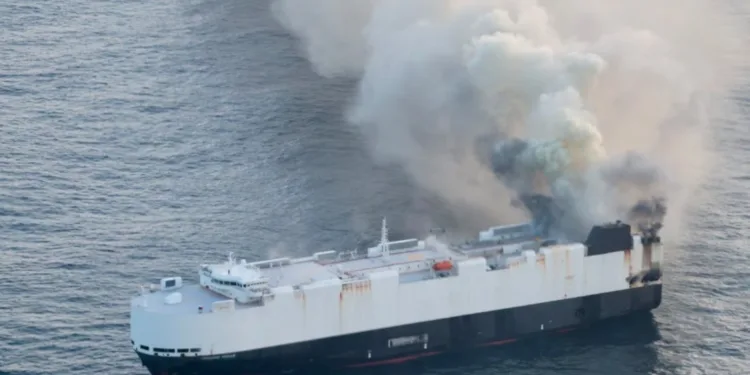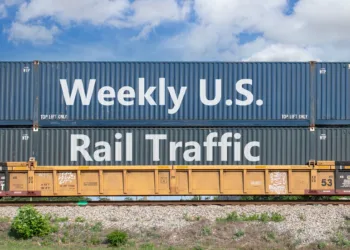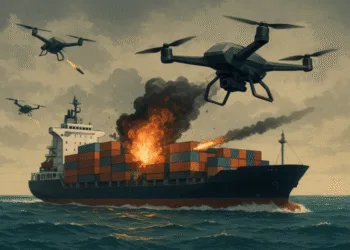Simon Hodgkinson, global head of loss prevention at West P&I, writes for Splash today on one of the greatest sources of casualties at sea in recent years.
Lithium-ion (Li-ion) batteries are now routine in shipping. They move as containerised cargo, sit inside vehicles on RoRo decks, and are increasingly installed on board to cut emissions. While their growing scale supports decarbonisation, global battery demand is projected to more than triple, hitting ~4.7 TWh by 2030 (up from ~700 GWh in 2022 and ~1 TWh in 2024), which increases exposure to Li-ion fire risks that many ships are not yet equipped to manage with conventional suppression systems.
The difference is thermal runaway: a self-heating chain reaction triggered by damage, defects, overcharge, or inadequate heat dissipation. Once underway it can drive rapid fire spread, flammable gas venting, and repeated re-ignition. The result at sea is a stubborn, hard-to-cool event where carbon dioxide, foam, or water mist may not perform as expected. Meanwhile, immersion tanks used ashore are rarely practical due to space and stability constraints, making prevention, early detection, and disciplined procedures the first line of defence.
Risk patterns vary by segment. On RoRo decks, enclosed spaces and limited ventilation magnify consequences when faults occur. EMSA’s FIRESAFE work indicates electrical faults account for ~60% of RoRo deck fires, and a separate RoPax study identified vehicle-origin electrical failures as the most common cause. Although headline incidents have not conclusively traced EV batteries as the initiator, ageing wiring, fluid leaks, and poor maintenance standards can provide the ignition, and once involved, nearby lithium-ion batteries escalate the fire through thermal runaway, complicating suppression.
In containers, cells and batteries are classed as dangerous goods under the IMDG Code, yet mis- or undeclared cargo persists despite CINS guidance. Without better detection and enforcement this blind spot remains. Bulk carriers face similar challenges when scrap cargoes contain electronic waste. These ships often lack the segregation, ventilation, and suppression capabilities such cargoes demand, and if buried in the heap, compromised cells can remain hidden until they ignite.
Battery-powered vessels are also multiplying, with the Maritime Battery Forum counting more than 1,500 in service worldwide. These systems enable lower-emissions operations but concentrate lithium-ion energy on board, heightening the importance of battery management systems, state-of-charge policies, and emergency procedures tailored to Li-ion behaviour.
Across segments, three gaps persist. Training is inconsistent, with no mandatory, standardised curriculum for crews and relevant port personnel on detection, cooling and containment, gas monitoring, and re-ignition risk. The Norwegian Maritime Authority is the exception, having issued detailed battery-system training guidance with strong potential for wider adoption. Equipment on many ships still relies on systems designed for Internal Combustion Engine (ICE) fires. Water helps with cooling but may not prevent re-ignition, and common agents struggle to interrupt thermal runaway. The 2019 Ytteroyningen ferry fire underlined this point: actions thought appropriate at the time were later judged ineffective. Regulation also lags. Class rules for energy storage are advancing, but international conventions like SOLAS have not kept pace with modern fire risks, particularly around EV carriage, leaving crews to navigate grey areas that uniform standards could resolve.
But there is progress to build on. Research, including work by RISE on state-of-charge thresholds and battery behaviour, is producing practical insight. Guidance on EV carriage and containerised batteries is improving, and knowledge-sharing between operators, ports, class societies, and insurers is evolving. What’s missing is consistency and scale.
The industry now needs a coordinated push that makes lithium-ion training mandatory, updates regulations to reflect real operating conditions, encourages investment in suppression solutions proven against thermal runaway at sea, and tightens cargo-declaration discipline through better detection and meaningful enforcement.
Li-ion fires are today’s test – and a precursor of what’s coming as new fuels enter service. The precedent we set now, in how we train, equip, and regulate for this distinct class of risk, will determine our readiness for the next generation of onboard hazards. The goal is simple: protect people, ships, and trade by matching modern risks with modern readiness.





















